
Related items loading ...
Section 1: Publication
Publication Type
Journal Article
Authorship
Huang, X., Rudolph, D. L., and Glass, B.
Title
A coupled thermal-hydraulic-mechanical approach to modelling roadbed frost loading on water mains
Year
2022
Publication Outlet
Water Resources Research, 58, e2021WR030933
DOI
ISBN
ISSN
Citation
Huang, X., Rudolph, D. L., and Glass, B.: A coupled thermal-hydraulic-mechanical approach to modelling roadbed frost loading on water mains, Water Resources Research, 58, e2021WR030933,
https://doi.org/10.1029/2021WR030933 , 2022
Abstract
The freeze-thaw cycle associated with climatic seasonality is a common phenomenon in cold regions affecting a wide range of subsurface processes. Due to the complex and highly nonlinear nature of the associated hydrologic processes, transient freeze-thaw dynamics are conventionally quantified in a numerical way. Here we present a hybrid analytical-numerical scheme for solving one-dimensional soil (or porous media) temperature profiles when the soil profile is subjected to unidirectional freezing (or thawing) conditions. This scheme divides the partially-frozen soil into multi-layers, each with constant thermal parameters and fixed-temperature boundaries. Temperature profiles within each layer were obtained by solving multiple moving-boundary problems. The proposed hybrid analytical-numerical scheme was tested into a freezing test of silty clay in a permafrost region on the Qinghai-Tibetan Plateau, and its solution was in good agreement with the finite element numerical solution. Results show that the proposed multi-layer method adapted well to the changes in unfrozen water content and thermal properties of soil over a wide range of subzero temperatures. By contrast, the freezing front's migration rate and penetration depth calculated by Neumann's classical solution, which only considers two zones (frozen and unfrozen), was found to be underestimated. As for our proposed multi-layer solution, by dividing the subsurface domain into many layers with smaller proportion ratios (thinner layers close to the freezing front), there was a slower penetration rate of the freezing front resulting in shallower penetration depth. The predicted profiles of temperature, thermal conductivity and diffusivity, heat flux, and dynamics of the freezing front were significantly impacted by the shape of the soil freezing curves and the magnitude of soil grain thermal conductivity, especially for the accuracy of long-term predictions.
Plain Language Summary
Section 2: Additional Information
Program Affiliations
Project Affiliations
Submitters
Publication Stage
Published
Theme
Presentation Format
Additional Information
Northern-Water-Futures, Refereed Publications


 GWFNet
GWFNet Master
Master Data
Data Research
Research Map
Map
 Advanced
Advanced Tools
Tools
 . . .
. . .
 Metadata Editor
Metadata Editor
 Record List
Record List
 Alias List Editor
Alias List Editor
 Legacy sites
Legacy sites